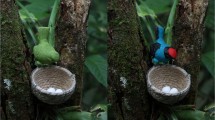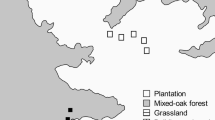Abstract
We investigated how the expression of carotenoid-based plumage coloration (lightness and chroma) in nestling blue tits Parus caeruleus is associated with forest structure in oak forests of central Spain. We found evidence of a reduced expression of carotenoid-based coloration in nestlings growing up in successionally young and structurally simple forest territories. Our results suggest that breast feather coloration can be used as an indicator of nestling quality because nestlings with more intense yellow plumage coloration had larger body size and stronger immune responses to the injection of phytohemagglutinin (PHA). Given the association of forest structural complexity with carotenoid-based plumage coloration, our findings suggest that variation in habitat structure may have a significant impact on forest birds in their first stages of life which has implications for forest management practices.


Similar content being viewed by others
References
Alatalo RV, Lundberg A (1986) Heritability and selection on tarsus length in the Pied Flycatcher (Ficedula hypoleuca). Evolution 40:574–583
Andersson M (1994) Sexual selection. Princeton Univ. Press, Princeton, NJ
Arriero E, Sanz JJ, Romero-Pujante M (2006) Habitat structure in Mediterranean deciduous forests in relation to reproductive success in the Blue tit Parus caeruleus: effects operate during laying and incubation. Bird Study 53:12–19
Blount JD, Houston DC, Møller AP (2000) Why egg yolk is yellow? Trends Ecol Evol 15:47–49
Blount JD, Metcalfe NB, Birkhead TR, Surai PF (2003) Carotenoid modulation of immune function and sexual atractiveness in Zebra finches. Science 300:125–127
Brokaw NVL, Lent RA (1999) Vertical structure. In: Hunter ML (ed) Maintaining Biodiversity in Forest Ecosystems. Cambridge Univ. Press, Cambridge, UK
Brush AH (1978) Avian pigmentation. In: Brush AH (ed) Chemical Zoology. Academic, New York, pp 141–164
Christe P, Møller AP, de Lope F (1998) Immunocompetence and nestling survival in the house martin: the tasty chick hypothesis. Oikos 83:175–179
Cichoñ M, Dubiec A (2005) Cell-mediated immunity predicts the probability of local recruitment in nestling blue tits. J Evol Biol 18:962–966
Costa M, Morla C, Sainz H (1998) Los bosques ibéricos. Planeta, Barcelona, pp 224–241
Cramp S, Perrins CM (1993) Blue tit. In: Cramp S, Perrins CM (eds) The birds of the western Palearctic, vol. 7. Oxford Univ. Press, London ,UK, pp 225–248
Díaz M (2003) Herrerillo Común Parus caeruleus. In: Martí R, del Moral JC (eds) Atlas de las Aves Reproductoras de España. Dirección General de Conservación de la Naturaleza-Sociedad Española de Ornitología, Madrid, pp 514–515
Eeva T, Lehikoinen E, Ronka M (1998) Air pollution fades the plumaje of the great tit. Funct Ecol 12:607–612
Endler JA (1980) Natural selection on color patterns in Poecilia reticulata. Evolution 34:76–91
Endler JA (1990) On the measurement and classification of colour in studies of animal colour patterns. Biol J Linn Soc 41:315–352
Figuerola J, Senar JC, Pascual J (1999) The use of colorimeter in field studies of Blue tit Parus caeruleus coloration. Ardea 87:269–275
Fitze PS, Kölliker M, Richner H (2003a) Effects of common origin and common environment on nestling plumage coloration in the Great tit (Parus major). Evolution 57:144–150
Fitze PS, Tschirren B, Richner H (2003b) Carotenoid-based colour expression is determined early in nestling life. Oecologia 137:148–152
Freund RJ, Littell RC, Spector PC (1986) SAS system for linear models. SAS Institute, Cary, NC
Gebhardt-Henrich S, Richner H (1998) Causes of growth variation and its consequences for fitness. In: Starck JM, Ricklefs RE (eds) Avian growth and development. Oxford Ornithology Series, New York, pp 324–339
Goodwin TW (1984) The biochemistry of the carotenoids. Animals. vol II. Chapman and Hall, London, UK
Götmark F, Ahlström M (1997) Parental preference for red mouth of chicks in a songbird. Proc R Soc Lond B 264:959–962
Griffiths R, Double MC, Orr K, Dawson JG (1998) A DNA test to sex most birds. Mol Ecol 7:1071–1075
Grether GF, Hudon J, Millie D (1999) Carotenoid limitation of sexual coloration along an environmental gradient in guppies. Proc R Soc Lond B 266:1317–1322
Hill GE (1991) Plumage coloration is a sexually selected indicator of male quality. Nature 350:337–339
Hill GE (1993) Geographic variation in carotenoid plumage pigmentation of male house finches Carpodacus mexicanus. Biol J Linn Soc 49:63–86
Hill GE (1999) Mate choice, male quality, and carotenoid-based plumage coloration:a review. Proceedings of the XXII International Ornithological Congress, Durban, pp 1654–1668
Hill GE (2002) Dietary carotenoids predict plumage coloration in wild house finches. Proc R Soc Lond B 269:1119–1124
Houde AE (1997) Sex, color and mate choice in Guppies. Princeton Univ. Press, Princeton, NJ
Huey RB (1991) Physiological consequences of habitat selection. Am Nat 137:S91–S115 (Supp)
Hunter M (1999) Maintaining Biodiversity in Forest Ecosystems. Cambridge Univ. Press, Cambridge, UK
Hõrak P, Vellau H, Ots I, Møller AP (2000) Growth conditions affect carotenoid-based plumage coloration of great tit nestlings. Naturwissenchaften 87:460–464
Hõrak P, Ots I, Vellau H, Spottiswoode C, Møller AP (2001) Carotenoid-based plumage coloration reflects hemoparasite infection and local survival in breeding great tits. Oecologia 126:166–173
John H, Birks B (2005) Mind the gap:how open were European primeval forests? Trends Ecol Evol 20:154–156
Johnsen A, Delhey K, Andersson S, Kempenaers B (2003) Plumage colour in nestling blue tits: sexual dichromatism, condition dependence and genetic effects. Proc R Soc Lond B 270:1263–1270
Kodric-Brown A (1989) Dietary carotenoids and male mating success in the guppy: an environmental component to female choice. Behav Ecol Sociobiol 25:393–401
Krebs EA, Putland D (2004) Chic chicks:the evolution of chick ornamentation in rails. Behav Ecol 15:946–951
Lindström J (1999) Early development and fitness in birds and mammals. Trends Ecol Evol 14:343–348
Littell RC, Milliken GA, Stroup WW, Wolfinger RD (1996) SAS system for mixed models. SAS Institute, Cary, NC
Lozano GA (1994) Carotenoids, parasites, and sexual selection. Oikos 70:309–311
Lyon BE, Eadie JM, Hamilton LD (1994) Parental choice selects for ornamental plumage in American coot chicks. Nature 371:240–243
McGraw KJ, Ardia DR (2003) Carotenoids, immunocompetence and the information content of sexual colors: an experimental test. Am Nat 162:704–712
McGraw KJ, Gregory AJ, Parker RS, Adkins-Regan E (2003) Diet, plasma carotenoids, and sexual coloration in the Zebra finch (Taeniopygia guttata). Auk 120:400–410
Merino S, Potti J (1996) Weather dependent effects of nest ectoparasites on their bird hosts. Ecography 19:107–113
Merino S, Møller AP, de Lope F (2000) Seasonal changes in cell-mediated immunocompetence and mass gain in nestling barn swallows:a parasite-mediated effect? Oikos 90:327–332
Milinski M, Bakker TCM (1990) Female sticklebacks use male coloration in mate choice and hence avoid parasitized males. Nature 344:330–333
Moreno J, Carrascal LM, Fargallo JA, Soto-Largo E (1996) Determination of clutch size in the Blue tit Parus caeruleus in central Spain: field experiments. Ardeola 43:9–17
Moreno J, Merino S, Sanz JJ, Arriero E, Morales J, Tomas G (2005) Nestling cell-mediated immune response, body mass and hatching date as predictors of local recruitment in the Pied flycatcher Ficedula hypoleuca. J Avian Biol 36:251–260
Morris DW (1987) Ecological scale and habitat use. Ecology 68:362–369
Møller AP, Saino N (2004) Immune response and survival. Oikos 104:299–304
Møller AP, Biard C, Blount JD, Houston DC, Ninni P, Saino N, Surai PF (2000) Carotenoid-dependent signals: indicators of foraging efficiency, immunocompetence or detoxification ability? Avian Poult Biol Rev 11:137–159
Olson VA, Owens IPF (1998) Costly sexual signals:are carotenoids rare, risky or required? Trends Ecol Evol 13:510–514
Orians GH, Wittenberger JF (1991) Spatial and temporal scales in habitat selection. Am Nat 137:S29–S49 (Supp)
Partali V, Liaaen-Jensen S, Slagsvold T, Lifjeld JT (1987) Carotenoids in food chain studies II. The food chain of Parus spp. Monitored by carotenoid analysis. Comp Biochem Physiol 87B:885–888
Potti J, Montalvo S, Sánchez-Aguado FJ, Blanco D (1988) La reproducción del Herrerillo común (Parus caeruleus) en un robledal del centro de España. Ardeola 35:31–43
Saino N, Ninni P, Calza S, De Bernardi F, Møller AP (2000) Better red than dead:carotenoid-based gape coloration reveals health status in barn swallow nestlings. Proc R Soc Lond B 267:57–61
Saino N, Ferrari R, Romano M, Martinelli R, Møller AP (2003) Experimental manipulation of egg carotenoids affects immunity of barn swallow nestlings. Proc R Soc Lond B 270:2485–2489
Saks L, Ots I, Hõrak P (2003) Carotenoid based plumage coloration of male greenfinches reflects health and immunocompetence. Oecologia 134:301–307
Sanz JJ (2001) Experimentally increased insectivorous bird density results in a reduction of caterpillar density and leaf damage to Pyrenean oak. Ecol Res 16:387–394
Senar JC, Figuerola J, Pascual J (2002) Brighter yellow blue tits make better parents. Proc R Soc Lond B 269:257–261
Senar JC, Figuerola J, Doménech J (2003) Plumage coloration and nutritional condition in the Great tit Parus major: the roles of carotenoids and melanins differ. Naturwissenschaften 90:234–237
Slagsvold I, Lifjeld JT (1985) Variation in plumage colour of the Great tit Parus major in relation to habitat, season and food. J Zool (Lond) 206:321–328
Smits JE, Bortolotti GR, Tella JL (1999) Simplifying the phytohaemagglutinin skin-testing technique in studies of avian immunocompetence. Funct Ecol 13:567–572
Suorsa P, Huhta E, Nikula A, Nikinmaa M, Jäntti A, Helle H, Hakkarainen H (2003) Forest management is associated with physiological stress in an old-growth forest passerine. Proc R Soc Lond B 270:963–969
Suorsa P, Helle H, Koivunen V, Huhta E, Nikula A, Hakkarainen H (2004) Effects of forest patch size on physiological stress and immunocompetence in an area-sensitive passerine, the Eurasian treecreeper (Certhia familiaris): an experiment. Proc R Soc Lond B 271:435–440
Svensson E, Nilsson J-Å (1995) Food supply, territory quality, and reproductive timing in the Blue tit (Parus caeruleus). Ecology 76:1804–1812
Tschirren B, Fitze PS, Richner H (2003) Proximate mechanisms of variation in the carotenoid-based plumage coloration of nestling great tits (Parus major L.). J Evol Biol 16:91–100
Tschirren B, Fitze PS, Richner H (2005) Carotenoid-based nestling colouration and parental favouritism in the great tit. Oecologia 143:477–482
Urban JF (2005) Modelling ecological processes across scales. Ecology 86:1996–2006
von Schantz T, Bensch S, Grahn M, Hasselquist D, Wittzell H (1999) Good genes, oxidative stress and condition-dependent sexual signals. Proc R Soc Lond B 266:1–12
Wagner HH, Fortin MJ (2005) Spatial analysis of landscapes:concepts and statistics. Ecology 86:1975–1987
Zanette L, Doyle P, Trémont SM (2000) Food shortage in small fragments:evidence from an area-sensitive passerine. Ecology 81:1654–1666
Acknowledgements
The study was financially supported by projects 07M/0137/2000 (Comunidad de Madrid) to LM Carrascal and BOS2001-0587 to J Moreno (Ministerio de Ciencia y Tecnología). M Romero-Pujante, JJ Sanz, S Merino, and A Martin helped in the fieldwork, and LM. Carrascal helped with the habitat structure data. We thank R. Fletcher for statistical advices concerning spatial correlation, and JA Davila and A Machordon for assistance with the molecular sexing. J Moreno, JC Senar, and two anonymous referees made valuable comments of early versions of the manuscript. EA was supported by a fellowship from El Ventorrillo-CSIC. El Ventorrillo field station provided the necessary facilities during the fieldwork. Comunidad de Madrid authorized the study.
Author information
Authors and Affiliations
Corresponding author
Rights and permissions
About this article
Cite this article
Arriero, E., Fargallo, J.A. Habitat structure is associated with the expression of carotenoid-based coloration in nestling blue tits Parus caeruleus . Naturwissenschaften 93, 173–180 (2006). https://doi.org/10.1007/s00114-006-0090-5
Received:
Accepted:
Published:
Issue Date:
DOI: https://doi.org/10.1007/s00114-006-0090-5




